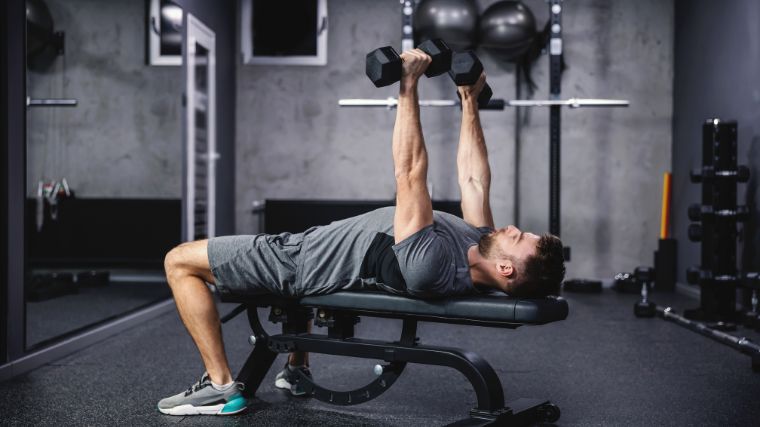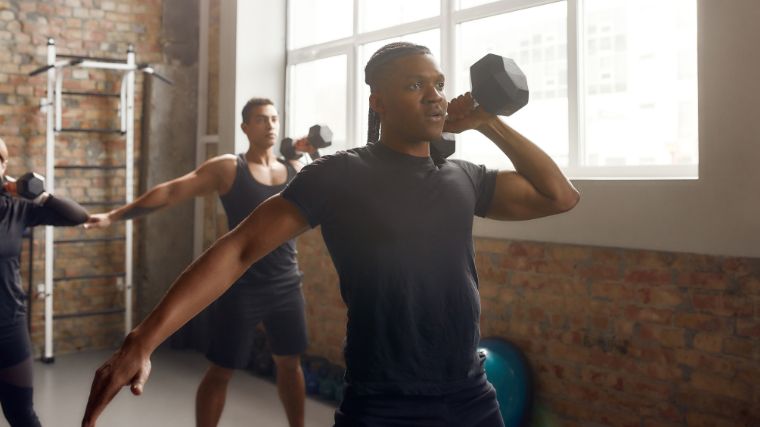The jury has reached a verdict: strength is very much in vogue. From “strong is the new skinny” slogans peppering social media platforms, to pro-lifting hashtags like #gainz adorning progress posts, to celebrity workouts built around a foundation of weight training, getting swole is all the rage.
But strength training is no fad — it’s a borderline prehistoric pursuit. The ancient Greeks competed in boulder lift-offs centuries before the first Olympic Games tested primitive weightlifting in 1896. 150-ish years later, “hitting the iron” is considered an integral part of any fitness routine worth its salt.

Why? Well, there’s a veritable mountain of scientific evidence legitimizing strength training (not that the Greeks needed proof of concept). One widely-cited study from 2012 all but confirms that strength-based exercise can improve “physical performance, movement control, walking speed, functional independence, cognitive abilities, and self-esteem.” (1)
So, if you’re itching for some lifting, you’ve come to the right place. This guide will teach you everything you need to know about strength training — how to start, how getting stronger actually works, and what you stand to gain along the way.
What Is Strength Training
On the surface, strength training is pretty self-explanatory; you train your body, both physically and mentally, to be stronger. Colloquially, “strong” can refer to any number of different qualities (a distance runner certainly has a strong heart), but strength training generally refers to lifting weights — external objects like barbells or dumbbells, or working with resistance machines.
How to Gain Strength
Gaining bodily strength is as much a mental game as it is about developing your muscles. Your body’s strength levels rely on both the size of your muscles and how adept your central nervous system is at contracting them quickly to produce force. However, strength is also contextual.
In the field of exercise science, clinicians and researchers recognize the SAID principle: That’s “specific adaptations to imposed demand.” Simply put, the SAID principle states that you will respond to the specific challenges you give yourself. If you try to throw a heavy rock as far as you can every day, you’ll get better at throwing that rock. The same idea applies to lifting a barbell, performing push-ups, or holding a plank as long as you can.

[Read More: The Complete Guide to Pre-Workout Supplements]
However, you won’t develop strength indefinitely if you don’t challenge your body to acclimate to heavier loads (or longer bouts). Eventually, that once-heavy rock will become manageable or even easy to throw. To make long-term progress, you need to apply some form of progressive overload.
Progressive Overload
Any well-designed strength training routine adheres to what’s called periodization, which refers to the organizational structure that guides your progress and gets you from “A” to “B”.
Periodized strength training programs are far more effective at developing strength than simply winging it in the gym, (2) largely because they guarantee that you’re inducing a level of progressive overload.
Think of progressive overload as the SAID principle in action — incrementally increasing the difficulty of a strength-based exercise by lifting a slightly heavier weight, performing another repetition, or holding a specific posture for a few seconds longer than last time.
The Strength Sports
While strength training is a noble and productive pursuit for anyone looking to get healthier, you can also test your strength and compete against athletes in different disciplines.
These strength sports have different criteria and unique cultures, but all operate under the same general directive as the ancient Greeks or the first Olympians: Find out who can lift the heaviest rock.
Powerlifting
Powerlifting is typically considered the most accessible of the strength sports. Athletes who train for and compete in powerlifting aim to test their maximal strength in three exercises; the bench press, back squat, and deadlift.

[Read More: The 12 Best Supplements for Muscle Growth]
You’ll find many recreational powerlifters in most commercial gyms, since the sport relies exclusively on the barbell, but dedicated (and career) powerlifters often train in sport-specific facilities around like-minded individuals.
Weightlifting
Weightlifting — as distinct from weight lifting — is an Olympic sport. Professional weightlifters compete in two movements, the snatch and clean & jerk, as tests of both maximum strength and explosive power.
The two competitive Olympic lifts are difficult to learn and even harder to master. Almost all weightlifters opt to practice their sport in specialized facilities under the tutelage of a qualified coach.
Strongman
Despite its name, the sport of strongman is open to athletes of all genders, and follows far less rigid competitive parameters than most other strength sports. Strongman athletes are still judged on how much weight they can move, but often work with all sorts of odd objects like sandbags, logs, niche barbells and boulders.
CrossFit
CrossFit is perhaps the most diverse of the modern strength sports. Athletes who partake in CrossFit test their capabilities across a wide array of athletic challenges. At its core, though, the sport regularly evaluates its competitors on their muscular strength.

[Read More: The Best Protein Intake Calculator for Muscle Gain and Fat Loss]
You’ll typically see CrossFit events that contain unique strength-based tests like a 1-rep-max “shoulder to overhead,” during which the athlete must hoist a bar above their head by any means necessary, or an “as many repetitions as possible” (AMRAP) strength-endurance challenge; lift a weight as many times as you can without stopping.
What Isn’t Strength Training
There’s no hard and fast rule delineating what strength-based activities count as strength training and which ones don’t. Most types of exercise depend on having a strong something.
However, activities like running, swimming, yoga, contact sports, or general calisthenics are not considered part of the strength training ecosystem because strength is not their primary goal (even though getting good at most of these activities requires hitting the weights in some form).
What About Bodybuilding?
Bodybuilding exists adjacent to, but relies heavily on, strength training. There’s plenty of debate about whether it is even a sport in the first place: Bodybuilding competitions contain elements of athleticism, but are judged primarily on aesthetics and appearances.
Regardless, bodybuilders lift weights religiously as part of their craft. After all, muscle doesn’t make itself. During the “off season,” when there’s no imminent competition, many bodybuilders dabble heavily in strength-focused weight lifting.
How To Start Strength Training
If you’re interested in improving your health, strength training is a no-brainer. In fact, the American College of Sports Medicine position stand (3) not only declares that weight training is beneficial, but that it should be undertaken several times per week using a variety of methods.
So, you can certainly waltz into your local gym and start tossing dumbbells around. Or you can follow a step-by-step procedure to guarantee you kick off your strength training journey on the right foot.
Step 1 — Establish a Schedule

Effective habits start with a schedule. One strength training session per week is certainly better than none, but an effective multi-day “split” is a must if you want to optimize your gains.
Most people perform strength training workouts anywhere from twice a week to six days per week. If you’re brand new to physical training, a three-day routine will do you just fine. It’s common to perform strength workouts on Monday, Wednesday, and Friday, for example.
Step 2 — Choose Your Style

Free weight exercise is the most ubiquitous form of strength training, but it isn’t the only way to increase your strength. You can dive into a specific strength sport like powerlifting, or begin by using bodyweight exercises instead. No matter what type of training you opt into, you’ll want to follow a pre-written routine rather than improvise your own:
- Your Complete Guide to Bodyweight Training
- The Beginner Bodybuilding Routine You Need to Start Building Muscle
- The BarBend Guide to Getting Started in CrossFit
- Best Powerlifting Workouts for Beginners
Step 3 — Start Slowly

If you’ve never hit the weights (or done a push-up) before, it is absolutely essential that you begin strength training slowly and patiently. The physiological stress of training for strength can be quite intense at first, since your body isn’t well-acclimated to bearing extra load.
Don’t get caught up in testing your strength before you build any. It’s far better to err on the side of “too easy” to begin with and ramp up the challenge over time.
What You’ll Need
Building strength, like anything else you do for your health, is an investment. That investment can take the form of a gym membership, a robust assortment of home gym essentials like dumbbell sets or resistance bands, or a lone yoga mat on your living room floor.
More than anything, though, you’ll need time — somewhere between 2 and 6 hours per week to dedicate to strength training early on. The more specific your strength training (think weightlifting or strongman), the more you’ll need specialty equipment that you can only find in certain gyms.
Benefits of Strength Training
Squatting more weight than last week, or throwing a heavy barbell over your head, or nailing your first pull-up, are addicting feelings. In a way, strength training is its own reward. But the benefits of training for strength don’t stop at stronger muscles. That’s just the tip of the iceberg.
More Strength (Duh)
Strength training makes you stronger. You don’t need a PhD in exercise physiology to work that out. However, there’s more to getting strong than just working out consistently. If you’re interested in getting as strong as possible, research shows that you need to commit to challenging training on a regular basis — lifting light weights lazily will only work for a little while. (4)
More Muscle
Strength and muscle go hand-in-hand. Your nervous system can only contract what muscle fibers you have, and a larger muscle equals larger and more powerful fibers. Strength training, especially when performed at sufficiently high volumes, will create muscle growth as well. And the larger your muscles are, the stronger they’ll be. (5)
Stronger Bones and Joints
Strength training isn’t just for those looking to beef up their muscles or put a lot of weight on their barbell. Weight lifting as a health practice has a veritable mountain of evidence behind it, particularly for its ability to strengthen connective tissues and mitigate fall risk. (6)(7)

[Read More: The 15 Best Shoulder Exercises For Building Muscle]
Your bones, joints, and tendons don’t experience hypertrophy and grow the way muscles do. However, the mechanical tension applied from strength training does improve the density and integrity of these structures.
Better Cardio
You might think of cardio and strength training as completely distinct from one another, but research suggests that they have something of a synergistic relationship. That is, strength training may improve your cardio game (and vice versa). (8)
Working with free weights won’t turn you into an all-star distance runner, but strength training does appear to confer some performance enhancements if you already partake in regular cardio.
Exercise Diversity
Maintaining a habit isn’t easy, especially if you feel stuck doing the same thing day in, day out. This is especially true of exercise, which is hard enough to perform on its own for many newcomers.
Adding some strength training into your fitness routine can inject some much-needed novelty. Instead of doing cardio back-to-back, you can sandwich in a weight training workout. Some data has also shown that changing your modality of exercise (particularly the type of weight lifting exercises you perform) is more effective than sticking to the same thing every session. (9)
Sample Strength Training Routines
Beginner strength training routines don’t need to be sophisticated. The “keep it simple, stupid” mantra applies just fine to exercise. However, you might find that the most frustrating part of starting strength training is working out the logistics in the first place.

Here are a few options for weekly strength training. The more workouts you can commit to during the week, the shorter each can be, but the inverse is true as well. If you only have two days to dedicate to the gym, expect those sessions to run a bit longer.
Two-Day Strength Training
If you can only make it to the gym twice a week, you’ll have to train your entire body each time — it’s wise to work out a given muscle group more than once per week. This means lots of compound, multi-joint exercises.
Day One
- Trap Bar Deadlift: 3 x 5
- Split Squat: 2 x 8
- Assisted Chin-Up: 2 x 15
- Dumbbell Bench Press: 3 x 6
- Side Plank: 3 x 20 seconds
Day Two
- Goblet Squat: 3 x 10
- Good Morning: 2 x 10
- Barbell Row: 3 x 6
- Standing Arnold Press: 2 x 8
- Face Pull: 1 x 20
- Bird Dog: 1 x 10 per side
Three Days
Three weekly workouts allows you to get a bit more specific. You’ll still work both halves of your body each time, but you won’t have to train both your chest and back on the same day.
Day One
- Back Squat: 3 x 6
- Dumbbell Row: 3 x 8
- Single-Arm Dumbbell Overhead Press: 2 x 10
- Dip: 1 x as many repetitions as possible
Day Two:
- Walking Lunge: 2 x 15
- Pendlay Row: 3 x 6
- Dumbbell Curl: 2 x 8
- Medicine Ball Slam: 3 x 20
Day Three
- Deadlift: 1 x 5
- Front Squat: 2 x 8
- Bench Press: 3 x 6
- Plank: 3 x 30 seconds
Four Days
A four-day workout split basically begs for an upper-lower style of training: Two days working your top half, and two days for legs. This provides plenty of real estate to include all sorts of different exercises, and each individual workout should take an hour or less.
Day One
- Back Squat: 3 x 5
- Single-Leg Romanian Deadlift: 2 x 10
- Leg Curl: 2 x 15
Day Two
- Dumbbell Row: 3 x 8
- Wide-Grip Lat Pulldown: 2 x 12
- Dumbbell Bench Press: 3 x 8
- Lateral Raise: 2 x 15
Day Three
- Trap Bar Deadlift: 2 x 5
- Step-Up: 2 x 8
- Leg Extension: 2 x 15
- Cable Crunch: 2 x 15
Day Four
- Assisted Chin-Up: 3 x 10
- Machine Chest Press: 3 x 10
- Band Pull-Apart: 2 x 20
- Hammer Curl: 2 x 15
- Skull Crusher: 2 x 15
How to Progress
If you’re consistent during your first few months of strength training, gains should flow pretty freely. You may find it possible to add a small amount of weight to several of your exercises on a weekly basis.
[Read More: Get Freakishly Strong With the 5×5 Workout Program]
As your body acclimates to the demands of exercise, your rate of progress will slow down somewhat. (After all, people can’t just add weight to their bars every week forever) If adding weight causes you to miss out on repetitions or compromise your form, try performing an extra rep instead, or cutting down on your rest times. There’s more than one way to gain strength.
Grow and Gain
Strength training is among the most rewarding things you can do for your body. The benefits are well-supported by scientific research, and the real-world changes speak for themselves. Whether you want to compete in a weightlifting competition, test your mettle on the field at a strongman event, or just want to improve a couple of health markers, strength training can get you there. All you have to do is get after it.
References
- Westcott W. L. (2012). Resistance training is medicine: effects of strength training on health. Current sports medicine reports, 11(4), 209–216.
- Williams, T. D., Tolusso, D. V., Fedewa, M. V., & Esco, M. R. (2017). Comparison of Periodized and Non-Periodized Resistance Training on Maximal Strength: A Meta-Analysis. Sports medicine (Auckland, N.Z.), 47(10), 2083–2100.
- American College of Sports Medicine (2009). American College of Sports Medicine position stand. Progression models in resistance training for healthy adults. Medicine and science in sports and exercise, 41(3), 687–708.
- Schoenfeld, B. J., Grgic, J., Ogborn, D., & Krieger, J. W. (2017). Strength and Hypertrophy Adaptations Between Low- vs. High-Load Resistance Training: A Systematic Review and Meta-analysis. Journal of strength and conditioning research, 31(12), 3508–3523.
- Akagi, R., Kanehisa, H., Kawakami, Y., & Fukunaga, T. (2008). Establishing a new index of muscle cross-sectional area and its relationship with isometric muscle strength. Journal of strength and conditioning research, 22(1), 82–87.
- Abou Sawan, Sidney; Nunes, Everson(1) A.; Lim, Changhyun; McKendry, James; Phillips, Stuart M.. The Health Benefits of Resistance Exercise: Beyond Hypertrophy and Big Weights. Exercise, Sport, and Movement 1(1):e00001, January 2023. | DOI: 10.1249/ESM.0000000000000001
- Hong, A. R., & Kim, S. W. (2018). Effects of Resistance Exercise on Bone Health. Endocrinology and metabolism (Seoul, Korea), 33(4), 435–444.
- Mikkola, J., Vesterinen, V., Taipale, R., Capostagno, B., Häkkinen, K., & Nummela, A. (2011). Effect of resistance training regimens on treadmill running and neuromuscular performance in recreational endurance runners. Journal of sports sciences, 29(13), 1359–1371.
- Fonseca RM, Roschel H, Tricoli V, de Souza EO, Wilson JM, Laurentino GC, Aihara AY, de Souza Leão AR, Ugrinowitsch C. Changes in exercises are more effective than in loading schemes to improve muscle strength. J Strength Cond Res. 2014 Nov;28(11):3085-92. doi: 10.1519/JSC.0000000000000539. PMID: 24832974.
Featured Image: Chokniti-Studio / Shutterstock
